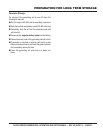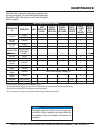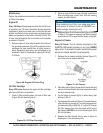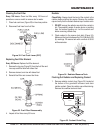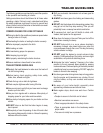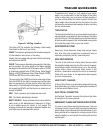
PAGE 38 — DA7000 SERIES GENERATORS• OPERATION AND PARTS MANUAL — REV. #5 (01/20/11)
TRAILER GUIDELINES
The following guidelines are intended to assist the operator
in the operation and handling of a trailer.
Safety precautions should be followed at all times when
operating a trailer. Failure to read, understand and follow
the safety guidelines could result in injury to yourself and
others. Loss of control of the trailer or tow vehicle can result
in death or serious injury.
COMMON CAUSES FOR LOSS OF TRAILER
Driving too fast for the conditions (maximum speed when
towing a trailer is 55 mph).
Overloading the trailer or loading the trailer unevenly.
Trailer improperly coupled to the hitch.
No braking on trailer.
Not maintaining proper tire pressure.
Not keeping lug nuts tight.
Not properly maintaining the trailer structure.
Ensure machine is towed level to tow vehicle.
TRAILER TOWING GUIDELINES
Recheck the load tiedowns to make sure the load will
not shift during towing.
Before towing, check coupling, safety chain, safety
brake, tires, wheels and lights.
Check the lug nuts or bolts for tightness.
Check coupler tightness after towing 50 miles.
Use your mirrors to verify that you have room to change
lanes or pull into traffi c.
Use your turn signals well in advance. Allow plenty of
stopping space for your trailer and tow vehicle.
Allow plenty of stopping space for your trailer and tow
vehicle.
DO NOT drive so fast that the trailer begins to sway
due to speed.
Allow plenty of room for passing. A rule of thumb is that
the passing distance with a trailer is 4 times the passing
distance without the trailer.
Shift your automatic transmission into a lower gear for
city driving.
ALWAYS use lower gears for climbing and descending
grades.
DO NOT ride the brakes while descending grades, they
may get so hot that they stop working. Then you will
potentially have a runaway tow vehicle and trailer.
To conserve fuel, don’t use full throttle to climb a hill.
Instead, build speed on the approach.
Slow down for bumps in the road. Take your foot off the
brake when crossing the bump.
DO NOT brake while in a curve unless absolutely
necessary. Instead, slow down before you enter the
curve and power through the curve. This way, the towing
vehicle remains in charge.
DO NOT apply the brakes to correct extreme trailer
swaying. Continued pulling of the trailer, and even slight
acceleration, will provide a stabilizing force.
Anticipate the trailer “swaying.” Swaying is the trailer
reaction to the air pressure wave caused by passing
trucks and buses. Continued pulling of the trailer provides
a stabilizing force to correct swaying. DO NOT apply the
brakes to correct trailer swaying.
Use lower gear when driving down steep or long grades.
Use the engine and transmission as a brake. Do not
ride the brakes, as they can overheat and become
ineffective.
Be aware of your trailer height, especially when
approaching roofed areas and around trees.
Make regular stops, about once each hour. Confi rm
that:
• Coupler is secure to the hitch and is locked.
• Electrical connectors are secure.
• There is appropriate slack in the safety chains.
• There is appropriate slack in the breakaway switch
pullpin cable.
• Tires are not visibly low on pressure.




